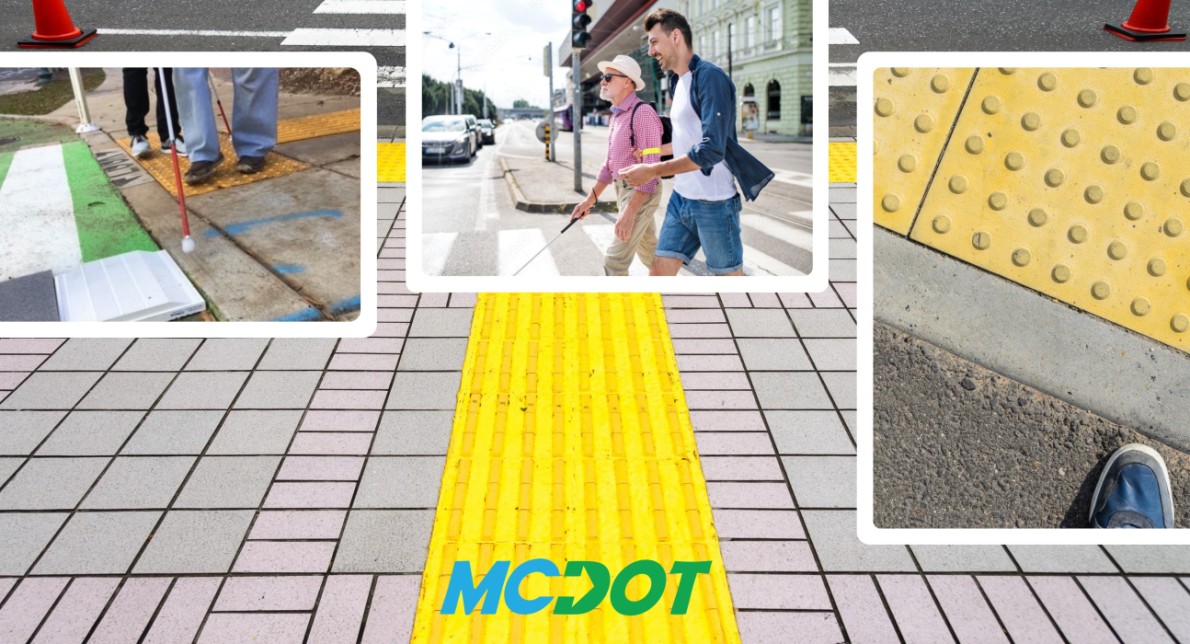Press Releases - Department of Transportation
First of Its Kind Street Design Guide to Improve Accessibility for People with Vision Disabilities Now Available from Montgomery County Department of Transportation
For Immediate Release: Monday, October 18, 2021

The Montgomery County Department of Transportation (MCDOT) now has available a first-of-its-kind design guide titled Planning and Designing Streets to be Safer and More Accessible for People with Vision Disabilities. The guide will facilitate accessibility for people who are blind or have low vision by outlining optimized strategies for public engagement, staff training and improved pedestrian walkway design.
The guide involved extensive input from residents, service providers and organizations supporting people with vision disabilities.
“Montgomery County is leading the nation with this guide on inclusive infrastructure design,” said Montgomery County Executive Marc Elrich. “Throughout COVID-19, our residents have enjoyed spending more time outdoors and walking. It is imperative that safe and accessible walkways and gathering spaces are built with everyone in mind.”
The work was funded through assistance from the Metropolitan Washington Council of Government’s (MWCOG) Transportation Land Use Connections (TLC) Program, and while the project was conceived and overseen by Montgomery County, it is intended to serve as a useful resource for the entire metropolitan region.
In addition to supporting safer and more consistent design approaches in the region, the toolkit will serve as a model for national guidance to bring global best practices in design for people with vision disabilities to the United States.
The guide incorporates feedback from the visually disabled community, service providers and caregivers. Engagement included a virtual community meeting in January of 2021, online surveys, in-person site visits and access to tactile graphics. Specifically, the project team observed how people with vision disabilities navigated Downtown Silver Spring and provided updates and sought feedback throughout the study process to the Montgomery County Commission on People with Disabilities.
“MCDOT aims to make our urban environment and transit centers accessible and safe for everyone,” said MCDOT Director Chris Conklin. “The guide was developed through a process of extensive community involvement, feedback and corresponding technical adjustments. Implementation of these recommendations will undoubtedly improve the lives of our residents and will set an example to support improvements on a national level.”
The toolkit can help planners and designers understand the unique needs of people with vision disabilities. It introduces strategies for effective engagement with this community and design tools that make it easier and safer for people with vision disabilities to navigate. Understanding how different types of vision disabilities impact the ability of people to navigate safely is critical to improving designs. The guide also includes an overview of the approaches taken, and lessons learned, from communities around the world.
For example, the toolkit offers guidance on creating tactile graphics so that people who cannot read paper plans are still able to be engaged in the planning process by access to plans that allow understanding of information through touch. Montgomery County used tactile graphics as part of the process of developing the toolkit and is already using tactile graphics with a project currently going through the planning process as a pilot to refine this form of outreach.
The design guide highlights three types of Tactile Walking Surface Indicators that can be used to guide blind and low-vision pedestrians. One of these is already used extensively in the United States and is required by the Americans with Disabilities Act. Known as the Detectable Warning Surface, the walkway inserts with truncated domes appear at the ends of crosswalks and train platforms or other areas where pedestrians may encounter conflicting traffic.
The guide introduces two additional tools that are not as common in the United States, but are used internationally. The first is the Detectable Guidance Surface, which is comprised of a walkway insert with linear surface of ridges and valleys (similar to Detectable Warning Surface, but with different shape and pattern) that people with vision disabilities can follow to navigate to key areas, such as the Accessible Pedestrian Signal push button, to cross wide-open spaces or to find transit stops. The second new design recommendation is use of the Detectable Delineator Surface, which can be used to delineate areas where pedestrians should not cross, but which may not be readily apparent to people with vision disabilities.
MCDOT is already working to put the toolkit to work.
“Within the next several months, we will be constructing a testing and training facility to use temporary materials to construct mock-ups of proposed designs so that blind and low-vision pedestrians can test out the designs in person and at real scale to determine whether additional changes are needed to improve accessibility,” said Matt Johnson, a capital project manager for MCDOT.
Following the development of the testing and training facility, and based on the feedback received there, the County will start work to apply the guide-recommended treatments at two pilot intersections in Downtown Silver Spring.
For details, to sign up for email updates about this project and to view the toolkit visit, montgomerycountymd.gov/DOT/Projects/TLCVision/.
For more information on MCDOT’s programs visit, montgomerycountymd.gov/dot. Follow @MCDOTNow on Twitter, and subscribe to MCDOT’s ‘Go Montgomery!’ newsletter.
# # #
Media Contact: Emily DeTitta, 240-372-2282 or [email protected]
Release ID: 21-143
Media Contact: Emily DeTitta, 240-372-2282



